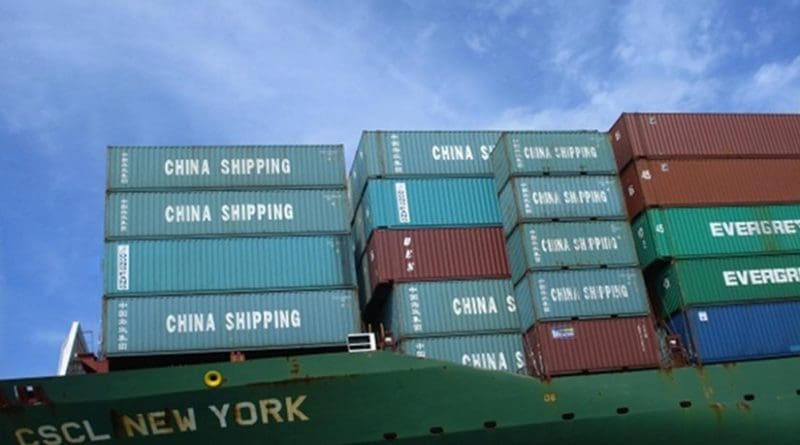Supply Chain Dependency: Decoupling From China? – Analysis
By RSIS
The COVID-19 pandemic has laid bare the pitfalls of the world’s heavy dependency on China as a manufacturing hub. Faced with supply chain disruptions, firms are under pressure from governments seeking to build resilience by decoupling from China. But is there a more politically and economically sustainable approach of achieving supply chain resilience?
By Yogaananthan S/O Theva*
The global economy is embroiled in the worst downturn since the Great Depression. Most countries, are witnessing record levels of unemployment and national debt. This is largely due to the disruption of supply chains in China caused by the pandemic.
Beata Javorcik, Chief Economist of European Bank for Reconstruction and Development, had aptly said: “One province of China went on lockdown, and suddenly factories all over the world don’t have supplies.” This reflects how most firms in the technology, automotive and electronics sectors have significantly relied on supply chains within China to maximise efficiency and cost savings. Resultantly, firms struggled to maintain operations during the virus outbreak.
New Era of Self-Sufficiency?
The global economic fallout has impelled governments from the West and Asia to persuade firms into reshoring their operations to attain supply chain resilience through self-sufficiency. In the United States, there is a greater emphasis by the Trump administration to decouple from China.
Peter Navarro, the US Director of Trade and Manufacturing Policy, has clamoured for greater self-sufficiency in manufacturing across different industries, asserting that America had outsourced too much of its supply chains to China.
In Europe, political fervour for greater strategic autonomy in supply chains has also intensified. This is evident in President Emmanuel Macron’s recent proclamation that France would strive for ‘full independence’ in the production of medical equipment. Similarly, in India, Narendra Modi has announced his economic stimulus plan and emphasised that a new era of economic self-sufficiency has begun.
Nevertheless, relocating supply chains outside of China is a challenging process. James Mcgregor, Chairman of APCO Worldwide’s Greater China Region, has observed that firms which have done so struggle to replicate China’s production capabilities.
China’s Advantage
Over the years, China has built a sophisticated supply chain network that enables suppliers of different sizes to collaborate at scale seamlessly. This network is bolstered by a vast distribution system that is built upon efficient transport infrastructure.
Additionally, China also offers a large and stable pool of workers who are competent and trained in operating complex machinery. Further, the Chinese government has been proactive in convincing firms of China’s unique competitive advantage as a manufacturing hub.
Further, the Chinese government has been proactive in convincing firms of China’s unique competitive advantage as a manufacturing hub. For example, officials from Zhengzhou have been appointed to help Apple Inc’s partner Foxconn recover from the disruptions caused by the pandemic. Additionally, the Ministry of Finance is increasing credit support to the manufacturing sector to help maintain operations.
Indeed, as firms re-examine their supply chains for a post-COVID 19 economy, the pressure from governments to reshore operations versus the attractiveness of China as a manufacturing hub will be a persistent geo-economic tension they will have to navigate.
Building Resilient Supply Chains: Three Strategies
To navigate the post-COVID 19 economy successfully, firms should avoid a rigid, binary approach of completely relying or decoupling from China. Instead, firms should pursue supply chain resilience by being nimble and strategically switching their operations between China and other countries when needed. This can be achieved through three key strategies.
Firstly, firms can invest in building ‘multi-source’ supply chain networks. This involves establishing a network of alternative suppliers, ‘just-in-case’ counterparts, that can be activated during a specific disruption in China or elsewhere. Importantly, these alternative networks should be geographically diversified to avoid a domino-effect in supply chain disruption in times of crises.
Secondly, firms should also invest in circular supply chains either as part of their main or alternative supply chain network. Circular supply chains enable firms to reuse discarded materials and remake them for resale. Using circular supply chain processes, firms such as Renault have been able to keep costs low even when raw materials are increasingly becoming susceptible to price volatility, especially during crises like the pandemic.
Hence, if supply chains in China or elsewhere are disrupted, firms can still rely on circular supply chains and incorporate a greater amount of reused materials in their production processes, allowing for more cost control while sustaining operations.
Thirdly, it is critical for firms to gain maximum visibility of all their supply chain networks to anticipate disruptions emanating from China or elsewhere and quickly switch to alternative supply chain networks when needed. This entails having real-time data on the level of inventories and output along different value chains.
Investing in a More Predictable Future
To achieve supply chain visibility, companies such as Corning, Emerson, Hayward, and IBM are utilising digital technologies such as blockchain.
Blockchain technology facilitates the creation of a complete, reliable, and unchangeable audit trail that tracks an asset from production to delivery. Armed with such data, firms will be able to quickly identify the specific supply chains that will be disrupted and activate alternative supply chains.
Cumulatively, these strategies are not without limitations. In the short-term, firms may incur high investment costs in acquiring the right technologies and designing and implementing new processes.
Finding alternative locations for operations and integrating newly established supply chains will be challenging. But in the long term, these are not liabilities, but necessary investments required to be resilient in the increasingly unpredictable post-COVID-19 geo-economic landscape.
*Yogaananthan S/O Theva is an Associate Research Fellow in the Policy Studies Group at the S. Rajaratnam School of International Studies (RSIS), Nanyang Technological University (NTU), Singapore. This is part of an RSIS Series.

